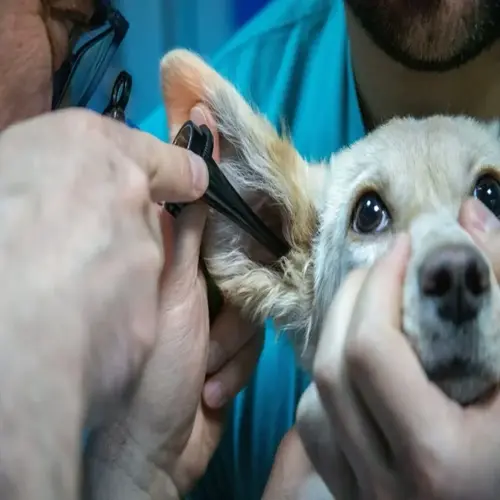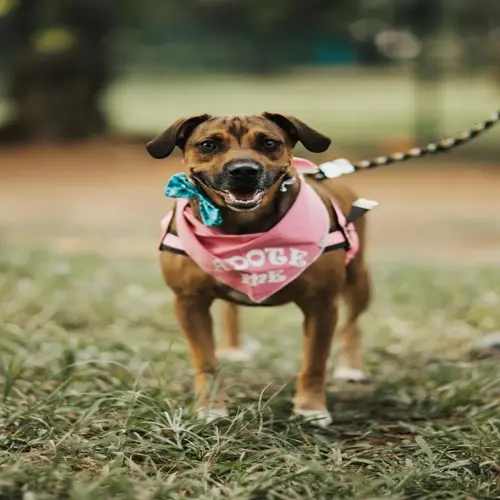10 Essential Dog Mental Stimulation Activities

Written by
Kailani Okoro
Reviewed by
Prof. David Walsh, Ph.D.You can prevent destructive behaviors in dogs that stem from boredom with mind-stimulating cognitive enrichment activities.
The best interactive chew toys for dogs will stimulate their chewing instincts, while also encouraging them to problem-solve.
Similarly, scent games engage a dog's inherent ability to track, while mentally stimulating their mind as well.
Training dogs in short durations has proven to maintain a better focus than longer-training sessions.
Dog food challenges -- i.e. toys designed to slow down a dog's fast eating tendencies -- promote cognitive enrichment while delaying their eating.
Mental stimulation provides positive benefits for all breeds, regardless of their age and energy level.
Article Navigation
Mental stimulation for dogs, such as learning new tricks, is as important for their health as physical walks. A bored dog becomes destructive, chewing furniture or digging up the backyard. The dog is not being disobedient; this is a sign that he is mentally hungry. Exercise both the mind and the body.
Mental exercise promotes the prevention of problem behavior, fosters confidence, and builds trust. It enhances your relationship and fosters mutual trust as you work through a few puzzles. All owners benefit from mental workouts, but it is beneficial for energetic breeds and pets who may be mobility-limited.
Discover ten essential activities to defeat canine boredom effectively. These proven methods tap into your dog's natural instincts. They transform idle time into rewarding challenges.
Why Mental Stimulation Matters
Dogs have an innate problem-solving intelligence calling for daily mental exercise, as people do. Their brains need to be challenged by stimulating instincts rooted in hunting and foraging habits. Without these exercises, cognitive decline can occur even in young dogs. Mental exercise keeps them sharp.
Failing to give a dog a mental workout can lead to destructive behaviors. Bored, they chew shoes, dig gardens, or bark excessively. This is not rebelliousness but an appeal to engage them. Your dog chews cushions because their mind is starving for challenges.
Working breeds such as Border Collies and German Shepherds require additional mental challenges because their breed expectations require them to complete more involved tasks. Other breeds that are less intense still need daily challenges and puzzles. All dogs benefit from activities that satisfy their natural drives.
Winning at scent games causes dopamine release in your dog's brain. This feel-good chemical rewards dogs for completing a specific problem. Doing so helps to create positive associations with mental work. Working their nose positively reinforces joy in your dog.
Cognitive Development
- Regular mental exercise maintains neural pathways and prevents cognitive decline in senior dogs. Problem-solving activities strengthen memory and learning capacity throughout a dog's life.
Behavioral Regulation
- Dogs without mental stimulation often develop destructive habits like excessive barking or digging. These behaviors typically diminish when dogs receive daily cognitive challenges.
Breed-Specific Needs
- Working breeds like Border Collies possess heightened intelligence requiring advanced puzzles. Their behavioral issues often stem from unmet mental exercise requirements.
Emotional Wellbeing
- Mental stimulation reduces anxiety by releasing calming neurotransmitters during scent games. Confident puppies emerge from successfully completing cognitive challenges independently.
Physical Health Support
- Mental exercises complement physical activity by engaging different muscle groups during problem-solving. Food puzzles encourage controlled movement while preventing rapid eating habits.
Top Interactive Puzzle Toys
Puzzle toys have different levels of difficulty according to your dog's abilities. Beginner toys, such as those made by Kong Classics, contain simple compartments for hiding treats; for advanced puzzle toys, such as Nina Ottosson, a multi-step solution is required. Choose wisely according to your dog's level of experience to avoid frustration-related problems.
When it comes to safety, material is important for strong chewers. Toys made of natural rubber can withstand heavy chewing and won't splinter. Plastic puzzles are suitable for mild-mannered dogs but should be avoided by heavy chewers. Always watch them while playing to prevent them from accidentally swallowing parts.
Make economical DIY alternatives with items you already have, place kibble in muffin tins, covered with tennis balls. Use cardboard boxes stuffed with crumpled-up paper and let your dog search for treats. Be sure to supervise your dog while playing with homemade enrichment items to ensure their safety.
Supervision is always necessary with any puzzle toys. Look for bite marks on rubber toys that indicate they may need to be discarded. After each use, check plastic puzzles to ensure they are not cracked. When engaging in DIY games, keep the dog away to limit potential choking hazards.
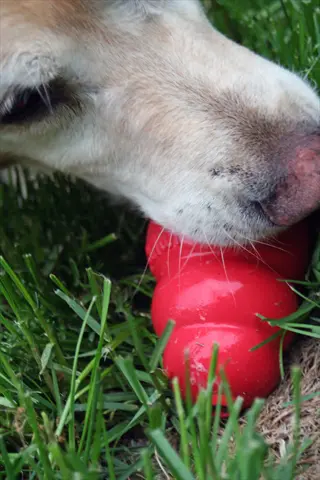
Kong Classic
- Made from durable natural rubber that withstands aggressive chewing while being gentle on teeth. Stuff with layered treats like peanut butter and kibble then freeze overnight for extended engagement.
- Available in ten sizes from extra-small to XX-large to accommodate all breeds. The erratic bounce pattern creates unpredictable movement that triggers natural prey drive instincts.
- Dishwasher-safe design simplifies cleaning after messy fillings like wet food or yogurt. Hollow center allows airflow to prevent bacterial growth during prolonged chewing sessions.
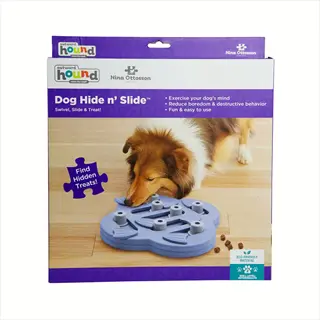
Nina Ottosson Dog Tornado
- Features four rotating tiers with hidden compartments requiring sequential pawing/nosing actions. Designed to develop problem-solving skills through multi-step solutions.
- Adjustable difficulty by adding/removing locking pins to control tier movement. Non-skid base prevents sliding during enthusiastic play on hard floors.
- Manufactured from pet-safe ABS plastic that withstands daily use without splintering. Wide compartments accommodate standard kibble size for regular meals.
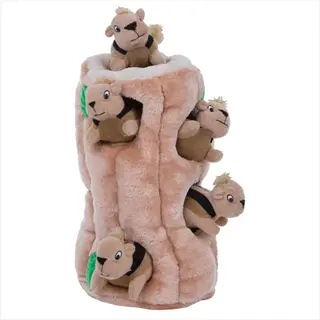
Outward Hound Hide-A-Squirrel
- Plush tree trunk houses three squeaky squirrels that dogs must extract individually. Encourages gentle mouthing skills through soft fabric components.
- Reinforced stitching prevents tearing during extraction attempts. Machine-washable materials maintain hygiene after outdoor play sessions.
- Squeakers inside each squirrel provide auditory rewards that reinforce successful retrieval. Ideal for dogs transitioning from destructive chewing habits.
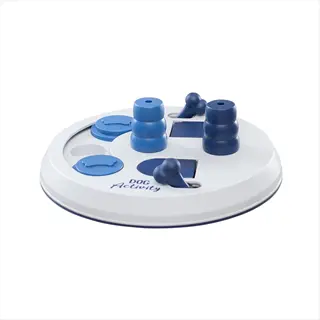
Trixie Activity Flip Board
- Wooden panel with eight sliding compartments revealing hidden treat chambers. Requires precise nose work and paw coordination to access rewards.
- Natural beechwood construction with non-toxic stains ensures safety during prolonged use. Angled design facilitates easier access for senior dogs.
- Removable rubber stoppers adjust difficulty from beginner to expert levels. Compact footprint (12x9 inches / 30x23 cm) fits small living spaces.
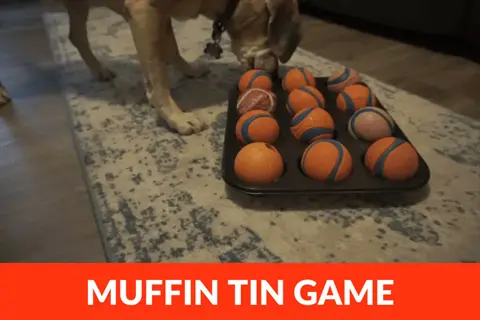
DIY Muffin Tin Puzzle
- Place treats in muffin tin cups then cover with tennis balls for nose-work challenges. Encourages sniffing and precise paw movements to dislodge covers.
- Adjust difficulty using different ball sizes or adding cardboard layers. Cost-effective alternative using common household items.
- Always supervise to prevent ball chewing or tin tipping. Ideal for sudden rainy-day enrichment without preparation time.
Engaging Scent Games
Scent games can be adapted to any size space, and can be executed in indoor trails or outdoor adventures. Indoors, you can create hiding places for treats under towels or at the legs of furniture. Outdoors, you can create paths through the grass by creating clusters of kibble. Start with simple paths, then increase the difficulty level as skill develops.
Plan treatment types in a way that maximizes effectiveness. Use kibble for sessions that are going to last a bit longer, with repeated hiding of multiple pieces. Reserve high-value treats like cheese or real meat for particularly challenging situations, retaining energy and excitement, and keeping the dog from sustaining too many calories in training.
Hound breeds are naturally excellent at tracking games due to their powerful sense of smell: bloodhounds and Beagles track trails with ease. However, non-hounds can also benefit immensely from developing their scent skills. Every dog loves to utilize its inherent sense of smell.
Safety comes first in scent activities. Keep away from small items that aggressive chewers can ingest. Be sure to inspect outside areas for poisonous plants before hiding treats. As always, supervise scent activities to prevent non-food items from being ingested.
Snuffle Mat Foraging
- Use fabric mats with deep folds to conceal dry kibble or small treats. Dogs must sniff through layers mimicking natural foraging behavior in safe indoor environments.
- Begin with simple spreads in shallow folds before progressing to rolled or knotted designs. Wash mats weekly to maintain scent effectiveness and hygiene standards.
- Rotate treat types between kibble and freeze-dried liver to sustain interest. Supervise to prevent fabric chewing during intense sessions.
Hot/Cold Find It
- Hide treats in progressively challenging locations starting under towels before advancing to closed drawers. Use vocal tone shifts to guide dogs toward targets.
- Say 'warmer' enthusiastically as they approach scents and 'cooler' calmly when moving away. Reinforce with immediate rewards for correct choices during training.
- Gradually phase out verbal cues once dogs understand nose-down searching patterns. Limit sessions to 10 minutes to prevent frustration buildup.
Backyard Scent Trails
- Create winding treat paths through grass or garden areas using small kibble clusters every 3 feet (1 meter). Encourage natural tracking instincts without formal training.
- Increase difficulty by placing treats under leaves or behind objects after mastering open trails. Use high-value rewards like cheese bits for advanced searches.
- Avoid toxic plants and pesticides during setup. Ideal for high-energy breeds needing combined physical and mental challenges.
Multi-Room Treasure Hunt
- Hide treats in themed locations like under couch cushions or behind doorways. Start with 3 obvious spots before expanding to entire house layouts.
- Use consistent verbal release cues like 'search' to initiate hunting behavior. Increase complexity by adding cardboard boxes as intermediate scent barriers.
- Time sessions to under 15 minutes to maintain engagement. Reward with favorite toys after successful completions for non-food motivated dogs.
Scented Towel Identification
- Rub distinct scents like lavender or coconut oil on identical towels. Train dogs to identify target towels using nose touches for rewards.
- Begin with one scented towel among plain ones before introducing multiple targets. Store scented towels separately to preserve aroma integrity between sessions.
- Use pet-safe essential oils diluted to 1% concentration. Avoid citrus or tea tree oils which may irritate canine olfactory systems.
Training for Mental Exercise
Basic commands like sit and stay create simple focus. Advanced training involves multiple commands such as fetching toys or closing doors. Start with simple commands and gradually increase the complexity until you have a series of commands in a row before completion. This helps to avoid unnecessary confusion and builds confidence.
Adapt exercise to suit your dog's strengths according to their breed. Herding breeds have the capacity to learn complex commands quickly. Short-nosed breeds will be easiest to work with when performing simple tasks with short intervals. Modifying exercise challenges to correspond to your dog's physical capabilities will ensure that your dog does not exceed its own physical limitations for large or senior dogs.
Limit the practice to about five minutes for beginners and ten minutes at the most. Several short drills are more effective than one long one. Quit before the child finds it wearying. Daily practice is more effective than occasional long sessions.
Safety precautions are necessary to avoid injuries when performing agility activities. Obstacles should be placed on non-slip or soft surfaces to prevent injury. Do not allow jumping for dogs under the age of eighteen months. Verify that the spots with the dog's feet are stable each time before each activity begins. Supervision is important so that unsafe activities can be corrected in a timely manner.
Food-Based Challenges
Portion control is a strategy implemented to avoid overfeeding during food challenges. You should subtract treat calories from your dog's daily meals. You can also measure kibble included in puzzles to provide balanced nutrition. Doing this will help provide other forms of mental enrichment without leading to unintentional weight gain.
Variations in texture bring about different levels of challenge. Frozen treats in Kong toys require a lot of licking, while dry kibble in snuffle mats requires sniffing abilities. Textural combinations of soft and crunchy are found in layered textures. Rotate the above to vary your dog's interest.
Evaluate breed restrictions judiciously. Brachycephalic dogs, such as Bulldogs, are especially challenged by strenuous tasks. Avoid frozen blocks, as they can strain the dog's jaw. Instead, select softer lick mats for your rewards. When working with a short-nosed dog, always prioritize safety over difficulty.
Oversee DIY challenges using household items. Cardboard boxes pose a risk of chewing and swallowing hazards. When your dog is foraging for treats, monitor for torn portions of the box. If your dog begins to chew and eat non-food items, intervene. Safety is of utmost importance before fun.
Stuffed Kong Variations
- Layer kibble, peanut butter, and mashed banana in a Kong toy before freezing overnight. Creates prolonged licking engagement that satisfies chewing instincts.
- Soak dry food in low-sodium broth for softer layers that release easier. Avoid xylitol-containing products which are toxic to canines.
- Vary fillings weekly: try canned pumpkin for digestion or Greek yogurt for probiotics. Always match portion sizes to your dog's dietary needs.
Scatter Feeding Techniques
- Spread daily kibble portions across grassy outdoor areas instead of bowls. Encourages natural foraging behavior while slowing eating pace significantly.
- Increase difficulty by hiding clusters under leaves or behind patio furniture. Start with visible piles before progressing to fully concealed food.
- Use snuffle mats indoors for rainy days, hide kibble in fabric folds. Wash mats weekly to prevent bacterial growth in damp environments.
Frozen Broth Treats
- Freeze low-sodium chicken broth with embedded blueberries in ice cube trays. Provides hydration and mental stimulation during hot weather.
- Use silicone molds with small compartments for portion control. Add shredded carrots for added texture and dental benefits.
- Supervise to prevent tooth damage from aggressive chewing. Limit to 1-2 treats daily to avoid gastrointestinal upset.
Puzzle Feeder Rotation
- Rotate between different puzzle toys weekly to maintain novelty. Use slow-feed bowls for beginners and complex mazes for experts.
- Clean devices thoroughly after wet food use with vinegar solutions. Avoid plastic toys for powerful chewers, opt for rubber instead.
- Time completion to adjust difficulty, aim for 5-10 minute sessions. Reward successes with verbal praise to reinforce positive associations.
Cardboard Box Foraging
- Hide kibble inside crumpled paper within cardboard boxes. Satisfies natural shredding instincts in controlled settings.
- Seal boxes with non-toxic glue instead of tape for safety. Place on tile floors for easy cleanup after destruction.
- Replace boxes weekly to maintain hygiene. Ideal for dogs transitioning from destructive chewing habits.
5 Common Myths
Only high-energy working breeds need regular mental stimulation to avoid behavioral problems.
All dogs benefit from cerebral enrichment, regardless of energetic temperament. Senior dogs, for example, show better retention with scent games and low-energy breeds like Basset Hounds gain confidence and self-esteem with food puzzles. Left to their own resources, even tranquil breeds develop neurotic habits or anxiety disorders. Five-minute daily intervals greatly improve quality of life, regardless of stage or age.
Many dog owners wrongly think that interactive puzzle toys are a substitute for physical walks and outdoor exercise.
Mental stimulation adds to but does not replace the need physical activity has. Walks provide cardio vascular well-being and sensory environmental exposure not possible through physical indoor activity for dogs, requiring both components. Puzzle toys, while good for engaging problem solving skills, do not fulfill the dog's need for instinctual sniffing, exploration and social activity met by walks. Balanced routines are necessary to keep dogs from becoming to overweight or suffering joint difficulties and provide them a wide variety of stimulation for total body, mind and spirit well-being.
Dogs boredom with mental exercises through repetition is natural and needs constant variety.
Get enough variety in the activities rotated properly and long-term interest can be maintained without continuous innovation. Dogs enjoy known patterns when the sessions last under 15 minutes and varying degrees of difficulty are exercised. When we play familiar games in different places or combine exercises such as scent trails and obedience, we are very much able to keep up a dogs interest in these various exercises for months. Continual even practices are found to really bolster a dogs confidence when it is found that through their repetition of the same every day problems they gain correctness and assurance in meeting these predictable problems of routine.
Hourly training sessions each day must be given to ensure success.
Short five to ten minutes in time are much more effective in holding the dog's attention than long drill sessions. Dogs learn by frequent and repeated contacts, which do not tire them. Many short sessions during the day reinforce the commands given in a single long session to the pleasure of both the dog and owner. This manner of training will give the dog better nerve connections through the principle of distributions.
Destructive chewing and digging behaviors are primarily indicators of disobedience or purposeful misbehavior.
These are more commonly hints of mental restlessness than of rebelliousness by the dog. Dogs with insufficient mental outlets redirect energy into destructive channels because of this mental restlessness. The appropriate toys and scent work usually reduce these behaviors by eighty percent in three weeks by getting to the root of the problem. Most trainers see this connection over a variety of breeds and living conditions.
Conclusion
Every dog, whether old or young, large or small, absolutely requires mental stimulation. Every breed is different, but every dog has cognitive needs. They will suffer mentally and physically without it. Make that a part of your daily routine, and you will love the results.
Let's review the four main activity categories we discussed. Puzzle toys turn dogs into problem-solvers. Scent games utilize their natural abilities. Training is about focus. Food puzzles reward persistence. Change them weekly to keep your dog engaged and excited.
Begin right now, using household items that you have all around you. Towels become scent trails. Cardboard boxes become foraging stations. Muffin tins become puzzle feeders. You do not need expensive gear - just your creativity and your dog's favorite treats!
Ongoing mental workout produces clear benefits. You'll see less chewing and digging. Your bond is strengthened through common challenges. Your dog demonstrates more confidence daily. Changes in behavior happen faster than you anticipate.
External Sources
Frequently Asked Questions
What constitutes 15 minutes of mental stimulation for dogs?
Fifteen minutes of effective mental exercise involves activities that challenge problem-solving abilities. Examples include completing a puzzle toy with hidden treats, following scent trails indoors, or practicing new obedience commands. These sessions prevent cognitive decline while avoiding frustration.
How can I mentally tire out my dog?
Mentally exhausting dogs requires combining physical and cognitive challenges:
- Rotate puzzle toys weekly to maintain novelty
- Create scent trails with kibble in grassy areas
- Teach multi-step commands like 'fetch and drop'
- Use food-dispensing balls during meal times
Is TV viewing mentally stimulating for dogs?
While some dogs show interest in moving images, television provides limited cognitive benefits compared to interactive activities. Dogs lack the ability to comprehend screen content meaningfully. Real-world scent games or puzzle toys offer significantly greater mental enrichment than passive viewing.
Do walks provide sufficient mental stimulation?
Walks primarily fulfill physical exercise needs but can be enhanced for mental enrichment:
- Vary routes to expose dogs to new scents
- Incorporate 'find it' games with hidden treats
- Practice obedience commands during pauses
- Allow extended sniffing time at interesting spots
What are signs of overstimulation in dogs?
Recognize these behavioral indicators of excessive mental strain:
- Excessive panting unrelated to temperature
- Compulsive circling or tail-chasing
- Refusal to engage with favorite toys
- Uncharacteristic growling during interactions
- Hiding or avoiding previously enjoyed spaces
Can dogs experience too much mental stimulation?
Yes, excessive cognitive challenges cause stress and behavioral issues. Limit sessions to fifteen minutes maximum, watch for frustration signs like whining or disengagement, and provide quiet recovery time afterward. Balance mental exercises with relaxation periods throughout the day.
How does mental stimulation prevent destructive behavior?
Cognitive enrichment addresses the root causes of destruction:
- Reduces boredom-induced chewing by satisfying instincts
- Decreases anxiety through confidence-building challenges
- Provides appropriate outlets for natural behaviors
- Tires the mind before physical energy accumulates
Are lick mats effective for mental stimulation?
Lick mats offer moderate cognitive benefits by encouraging focused licking motions that release calming endorphins. For optimal results, combine with other activities: freeze them for added difficulty or hide small treats within textures to engage problem-solving skills beyond basic licking.
Do all dog breeds need mental stimulation?
Cognitive enrichment benefits every breed regardless of energy levels:
- Working breeds require complex problem-solving tasks
- Companion breeds need confidence-building games
- Senior dogs benefit from memory-retention activities
- Low-energy breeds thrive with short daily puzzles
What happens without regular mental stimulation?
Dogs deprived of cognitive challenges develop both behavioral and health issues:
- Increased destructive chewing and digging
- Excessive barking due to frustration
- Cognitive decline accelerating in senior years
- Anxiety disorders manifesting as aggression
- Obesity from lack of engaging activities
